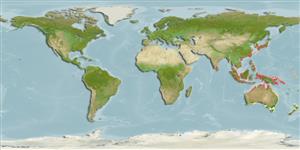Environment: milieu / climate zone / Mức độ sâu / distribution range
Sinh thái học
Biển Cùng sống ở rạn san hô; Mức độ sâu 5 - 20 m (Ref. 90102). Tropical
Indo-West Pacific: India east to Sagami Bay, Japan and China. A new record was reported from southern Indonesia (Ref. 5978).
Bộ gần gũi / Khối lượng (Trọng lượng) / Age
Chín muồi sinh dục: Lm ? range ? - ? cm
Max length : 14.0 cm TL con đực/không giới tính; (Ref. 559)
Các tia vây lưng cứng (tổng cộng) : 10; Các vây lưng mềm (tổng cộng) : 12; Tia cứng vây hậu môn: 3; Tia mềm vây hậu môn: 6. Distinguished from C. aprinus by the bright yellow coloration when viewed underwater (Ref. 48636).
Body shape (shape guide): short and / or deep; Cross section: compressed.
Occurs on rocky cliffs in deep water (Ref. 9710). Also inhabits muddy substrates in protected bays where wave action has no influence (Ref. 48636). Solitary (Ref 90102).
Life cycle and mating behavior
Chín muồi sinh dục | Sự tái sinh sản | Đẻ trứng | Các trứng | Sự sinh sản | Ấu trùng
Bi-directional sex change has been confirmed for this species (Ref. 103751). Sexual pattern seem to be intermediate between simultaneous and sequential hermaphroditism: individuals, at least under conditions of captivity, have the capacity to change sex in either direction, from functional male to functional female, or vice versa (Ref. 31569).
Masuda, H., K. Amaoka, C. Araga, T. Uyeno and T. Yoshino, 1984. The fishes of the Japanese Archipelago. Vol. 1. Tokai University Press, Tokyo, Japan. 437 p. (text). (Ref. 559)
IUCN Red List Status (Ref. 130435: Version 2025-1)
Threat to humans
Harmless
Human uses
Các công cụ
Special reports
Download XML
Các nguồn internet
Estimates based on models
Preferred temperature (Tài liệu tham khảo
123201): 21.4 - 29.3, mean 28.7 °C (based on 1745 cells).
Phylogenetic diversity index (Tài liệu tham khảo
82804): PD
50 = 0.5039 [Uniqueness, from 0.5 = low to 2.0 = high].
Bayesian length-weight: a=0.01445 (0.00715 - 0.02923), b=3.07 (2.89 - 3.25), in cm total length, based on LWR estimates for this species & (Sub)family-body (Ref.
93245).
Mức dinh dưỡng (Tài liệu tham khảo
69278): 4.0 ±0.67 se; based on food items.
Fishing Vulnerability (Ref.
59153): Low vulnerability (10 of 100).
🛈
